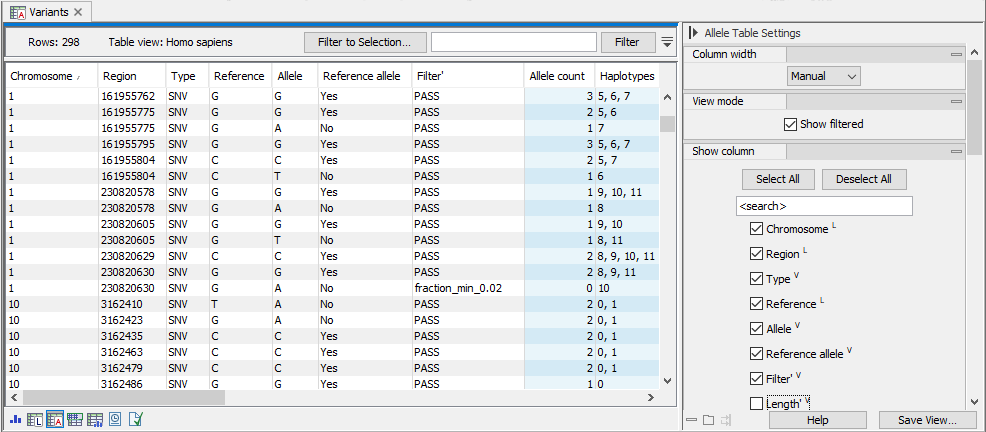Allele table
The allele table (figure 13.8) displays all genotype track alleles, one variant per row. All available genotype track annotations refer to either the locus-, variant- or haplotype-level. This is indicated in the side panel by the superscript: L = Locus annotation, V = Variant annotation, and H = Haplotype annotation. The displayed columns in the allele table are variant- and haplotype annotations by default. Variants where filters apply are displayed when the option 'Show non-PASS' is enabled. Blue columns are sample specific annotations, corresponding to FORMAT annotations in VCF (for a more detailed description of VCF compatibility, see section 13.2.7)
Below are descriptions of general allele table annotations.
- Chromosome
- The name of the reference sequence where the allele is situated.
- Region
- The reference sequence positions of the locus. The region may be either a 'single position', a 'region' or a 'between position region'.
- Type
- Allele variants are classified into five different types:
- SNV. A single nucleotide variant. This is also often referred to as a SNP.
- MNV. A multi nucleotide variant, which has the same number of nucleotides as the reference allele.
- Insertion. A variant that solely differs from the reference by having one or more adjacent bases inserted.
- Bond. The reference allele of a heterozygous insertion.
- Deletion. A variant that solely differs from the reference by having one or more adjacent bases deleted.
- Replacement. A variant that differs from the reference by length, and by having one or more bases replaced by one or more bases. This is also referred to as a delins. An example could be
AAA->CC.
- Reference
- The reference allele nucleotide sequence of the locus. Maximally 20 nucleotides are shown. Longer sequences can be obtained in their entirety by copy-pasting the table cell.
- Allele
- The allele. Nucleotide sequence is shown if this is a simple small variant.
- Reference allele
- Describes whether the allele is identical to the reference with a 'Yes' or 'No'. This can be useful for table filtering and sorting.
- Filter'
- List of filters that are directly or indirectly applicable to the allele variant. The value 'PASS' specifies that the variant passed all filters. Filter' is similar to the locus level Filter annotation, though describes a higher level of genomic detail (variant level), which is denoted by the appended '.
- Alt Length
- Length of the part of the allele that is altered relative to the reference, e.g. for deletions the number of deleted symbols and for insertions the number of inserted symbols. Leading and trailing sequence identical to the reference is not included.
- Length
- Total allele length within this locus. Includes any leading and trailing sequence identical to the reference.
- Variant filter
- Allele variant specific filters.

Figure 13.8: The allele table. To go to the allele table view of a genotype track as shown here, select the table icon with an A in the lower left corner. Note that in this example, "Show non-PASS" has been checked in the side panel and filtered alleles are shown in the table. Columns displayed can be adjusted by selecting and deselecting columns in the side panel to the right.
Sample annotations
The following annotations are available in sample genotype tracks.
- Allele count
- Count of alleles at this locus, identical to this allele variant. Based on separation of haplotypes the variant is part of, as well as the number of haplotype copies (figure 13.8).
- Haplotypes
- Haplotype identifiers. All sample alleles are part of one or more haplotypes. Haplotypes are groups of phased alleles that are linked together in the same DNA molecule. An allele may be part of multiple haplotypes describing different aspects of the same DNA molecule (figure 13.8).
- Haplotype loci
- The number of loci the haplotype spans, including filtered.
- Haplotype allele filter
- Applicable haplotype allele specific filters.
